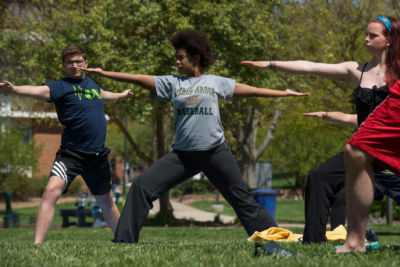By: Philip Wilkerson, Employer Engagement Consultant, University Career Services
“All truly great thoughts are conceived by walking.” – Friedrich Nietzsche
In recent years, walking meetings have gained popularity among professionals. Walking meetings provide opportunities to meet that don’t require sitting in a conference room or behind a desk. During walking meetings, you discuss work matters while walking outside, walking around a building, or even while connected remotely with colleagues through mobile devices. Walking meetings may seem unconventional, but they offer proven benefits. Beyond the physical well-being benefits of walking in general, walking meetings can boost both your social well-being and your productivity.
Walking has been an instrumental tool for my own well-being. As someone who is neurodivergent, I realized that I needed to implement walking as a concrete strategy to help me be more productive and efficient at work. Additionally, I am an extreme extrovert, and walking around people or with people truly re-energizes me. I have so many positive memories revolving around some form of walking. Whether it’s a stroll with a friend or mentor or a brisk walking meeting with a colleague, I’ve found that walks are excellent tools for boosting well-being.
The Social Well-Being Benefits of Walking Meetings
Walking meetings provide a unique opportunity for individuals to connect with their colleagues on a personal level, leading to improved social well-being.
Research has found that walking can lead to increased social interaction, as people are more likely to engage in conversation while walking. In Italy, there is a tradition called La Passeggiata, which refers to leisurely strolling up and down the town’s main street with family or friends. This tradition takes place regularly throughout each year, as a way for the community to reconnect and build community.
Walking together during meetings can help colleagues build stronger relationships and foster a sense of camaraderie. A study conducted by Stanford University found that walking meetings can lead to increased collaboration and creativity. The study found that walking meetings can create a more relaxed and informal atmosphere than traditional meetings, which can help individuals feel more comfortable sharing ideas and opinions. Also, the physical activity can help individuals feel more energized and alert, leading to improved cognitive function and problem-solving skills.
Walking and talking have allowed me to get to know people. Before the passing of my father-in-law, Jeff Kirsch, we would walk up and down our street discussing our lives and goals. It felt like one of those Kung Fu movies with the master guiding the pupil. I still talk with my mother-in-law and wife to debrief the day and meet with my mentor on campus. Walking on campus has also allowed me to get outside my silo and run into others around campus, increasing my chances of collaboration and partnership. With a campus as diverse and vibrant as Mason, walking has exposed me to many cultures and ways of living.
Just as you can engage with your local community more through walking and meeting your neighbors, you can engage with your work colleagues more by enjoying walking meetings together.
The Productivity Benefits of Walking Meetings
Walking meetings can also lead to increased productivity.
The physical act of walking benefits mental well-being in many ways that are linked to strong productivity, such as less stress and more concentration and creative ideas, writes Whitney Hopler in this Thrive Global.com article.
In this Integrify.com article, Deanna deBara shares that taking short breaks from the task at hand can help people focus more and concentrate better. Walking during work can help relieve stress, regain focus, and spark creativity. All of those benefits can make you more productive at work.
Walking meetings can boost productivity by reducing distractions in offices, relieving mental fatigue, and restoring the mental pathways to focusing attention, writes Dr. Wayne Jonas in this Psychology Today.com article.
My best ideas come to me when I am walking, and when I take a break to walk, I feel recharged and able to tackle so much more. I used to be concerned that people would assume I was slacking off from my work when I would get up from my desk and take a lap around campus. Years ago, when I had just joined University Career Services, a colleague named Kathy was walking in a loop around the third floor of SUB 1. I asked to join her and asked why she did these walks so often. She told me it was her way of staying fit and giving her mind a break so that she could go back to her desk ready to work. After that initial conversation, I often joined her for these loops around SUB 1 or walked alone.
Now, I use a Pomodoro Timer to ensure I do 40 minutes of uninterrupted work before I get up and walk – and then return from my walks energized to be productive again.
Tips for Walking Meetings
If you’re interested in incorporating walking meetings into your work routine, here are a few tips to keep in mind.
First, consider the weather and time of day when scheduling walking meetings. If it’s too hot, cold, or rainy outside, it may be best to reschedule or choose an indoor location for the meeting.
Also, scheduling walking meetings during peak business hours may not be practical, so be sure to choose a time when everyone is available.
Make sure to choose a walking route that is safe and comfortable for all participants. It’s also important to ensure that the route is accessible for people with disabilities or mobility issues. If you’ll be meeting remotely while connected through mobile devices and walking, everyone can choose their own route.
Finally, it’s important to communicate the purpose and expectations of each walking meeting to all participants. Let them know ahead of time that the meeting will involve walking and provide any necessary information about the route, distance, and duration.
Conclusion
Walking meetings offer numerous benefits for social well-being and productivity. Research has shown that walking can lead to increased social interaction, collaboration, and creativity, as well as improved cognitive function and problem-solving skills. If you’re looking for a new way to improve your work routine, consider incorporating walking meetings into your schedule. Not only will you enjoy the health benefits of physical activity, but you’ll also have the opportunity to connect with your colleagues on a personal level and improve your productivity. Please join me or say hello if you see me walking around campus. Let’s get moving, Patriots!
Additional Resources
This HBR.org article features tips for walking meetings.
This Iowa State University article explains how to host a walking meeting.
This Forbes.com article explores how leaders can hold walking meetings successfully.
Write one of these Thriving Together Series features! We’re looking for contributions on all topics related to well-being. Read other Thriving Together Series articles here and contact us at [email protected] for guidelines. Thank you for helping our Mason community thrive together online!






















